
According to legend, Thomas Jefferson was walking along a street in Paris, when he spied the famous painter Maria Cosway. He leapt over a fence to get close to her—and fell and broke his wrist. How did this girl, born to English parents in Florence, Italy, become an artistic luminary in the innermost circles of London society—and so ensnare the heart of Thomas Jefferson? Maria (rhymes with Messiah) Cosway is about to make her public debut for Colonial Williamsburg in New Orleans for the 95th Annual Conference of the National Council for the Social Studies. Portrayed by… me.
I’m no stranger to presenting at national conferences, as that’s a major part of my job with Colonial Williamsburg. Our mission is to take American history to new and distant audiences across the country, knowing that an encounter with a historical character will inspire them to take the journey to Williamsburg and experience those stories first-hand. I have an MFA in Classical Theatre from George Washington University, so my colleagues thought this was a fantastic opportunity for me to put all of my skills to use—acting, historical research, and the ability to wear really big hair.
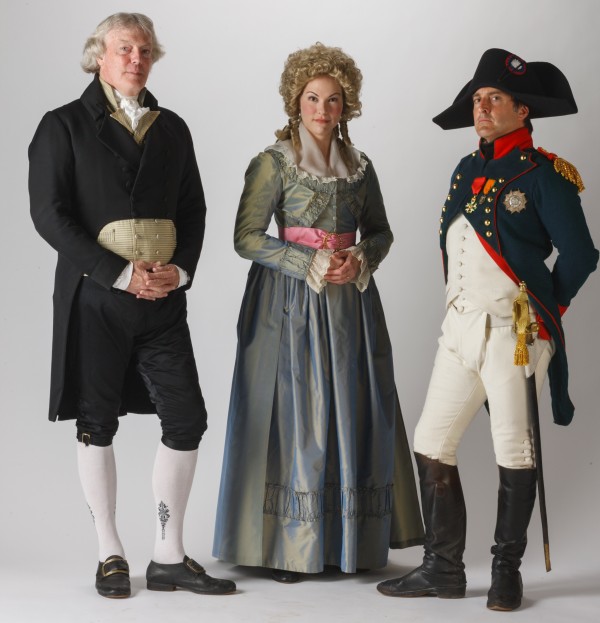
When I had the opportunity to meet Barbara Oberg, the preeminent authority of Jefferson in the United States and scholar of the Jefferson Papers at Princeton, I explained that I was about to take on portraying Maria Cosway. Dr. Olberg has spent years reading Jefferson’s mail. She grabbed my hands, looked me square in the face and stated, “You know, she was the love of his life.”
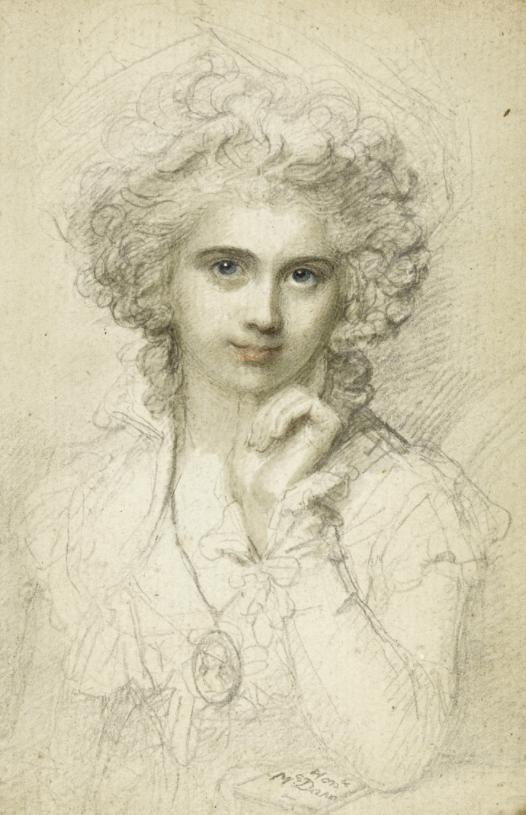
Maria Cosway by Richard Cosway, 1785
Born Maria Louisa Catherine Cecilia Hadfield on June 11, 1760 to British parents in Florence, Italy, Maria was a skilled artist in her own right, exhibiting more than 40 works of art at the London Royal Academy. She took up painting at age eight, and her father saw to it that she had the finest tutors in all of Italy to help foster her talent. By the time she and her mother moved to London, Maria had already been admitted to the Accademia di Disegno of Florence, similar to the Royal Academy in London. Once she reached London and married Richard Cosway, she had high hopes for her artistic career. But Richard did not want his wife to be a “professional” artist. She could exhibit her work as part of his studio, but she could not earn a living from her work. She would find this arrangement to be very stifling as their married life progressed.
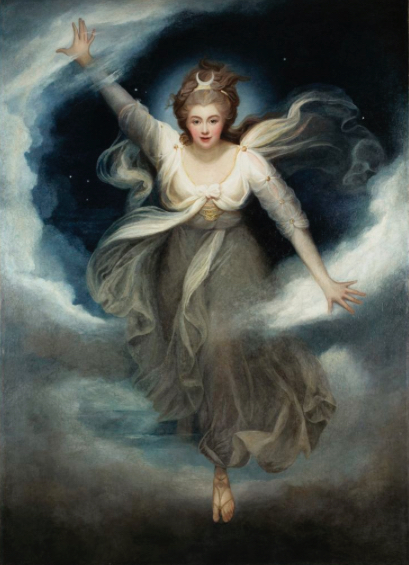
Georgiana, Duchess of Devonshire, as Cynthia from “The Fairie Queen,” by Maria Cosway, 1781-1782
One of her greatest works, The Hours, was exhibited at the Royal Academy in London in 1783. Soon immortalized by the engraver Francesco Bartolozzi, her work became very popular in Paris, where it impressed Thomas Jefferson in 1788. Jefferson wrote to her, “Your hours, my dear friend are no longer your own. Everybody now demands them: and were it possible for me to want a memorandum of you, it is presented me in every street of Paris.”
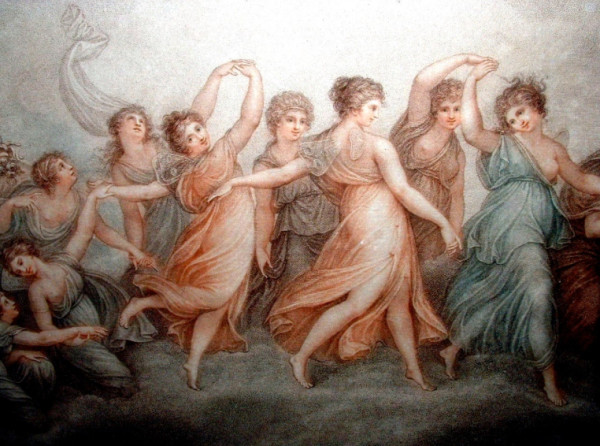
The Hours, engraving by Francesco Bartozlozzi, by Maria Cosway, 1788
Jefferson and Cosway met for the first time in Paris in September 1786. She was there on a trip with her husband and Jefferson, of course, was the U.S. Ambassador. It was during these weeks spent touring Paris that Jefferson formed an… attachment towards Maria… one that has had historians speculating its extent and nature ever since. Maria was a practicing Catholic, and for her, divorce was out of the question. She had married Richard Cosway more out of financial necessity than love, and Maria’s mother had arranged it all. Jefferson had been recently widowed and, although 17 years her senior, found a kindred artistic spirit in Maria.
I have come to the conclusion that, had they met in America, their relationship probably would not have blossomed. But in the Paris of the 1780s, away from both Jefferson’s new republic and the confines of London society, these two remarkable individuals developed a relationship that would last the rest of their lives.
If you want a really good romantic read—clocking in at some 12 handwritten pages, in Jefferson’s left hand, no less (as he’d hurt his right wrist jumping over that fence), check out Jefferson’s Head and Heart Dialogue. It is a heart-tugging ode to his days with the Cosways in Paris. Here’s a link to the full transcript of the letter at the National Archives.
But besides being Thomas Jefferson’s “impossible love,” Maria is also the Kevin Bacon of the late 18th and earlier 19th centuries. She knew everyone! Are you a fan of Alexander Hamilton? She was BFFs with Angelica Schuyler Church, one of those swanky Schuyler sisters. Maria was so close to Louise de Stolberg, Countess of Albany and wife of Charles Edward Stuart—better known as “Bonny Prince Charlie”—that Maria’s daughter was named after Louise, who was her godmother. There’s a great story about Louise being summoned to Paris in 1809 by Napoleon and asked if she’d borne a child by Charles Edward. Napoleon wanted to use this heir to cause an insurrection in Britain. When Louise told Napoleon there was no such child, she was promptly dismissed.
Oh, and of course, Maria knew Napoleon Bonaparte himself. Maria would move to Paris from London in 1801 as her marriage to Richard would take a rocky turn due in part to the death of their only child Louisa in 1796. Her plan was to copy the Italian works in the Louvre that Napoleon had acquired (aka plundered). She created a portfolio of these works and put a fantastic spin on the whole plundering bit by stating that “the history of every picture will be very curious as we have collected in one spot the finest works of art which were spread all over Italy.” She had a red Moroccan leather folder that contained miniatures of these works, and more importantly the signatures of those individuals who had subscribed to these works. Her most precious signature was that of Napoleon himself. Her plan to copy all of these great Italian works would unfortunately fail, but it put her in a position in 1803 to take on what she felt was her life’s calling: education. She would open two schools, the first in Lyons, France and second, her pride and joy, the College of Beata Vergine della Grazie in Lodi, Italy. In Lodi, she ended her days surrounded by the girls who had essentially become her adoptive family. Thanks to Maria, these students received an enlightened education unlike any other that could be offered in Europe.
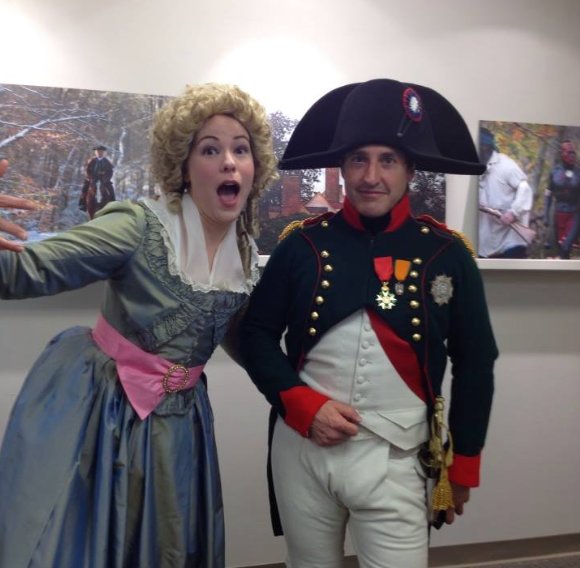 It has been so fulfilling to get to explore this exceptional woman’s life for over a year now. She was truly a self-made woman She knew the most important historical figures of her day and had such a keen intellect that she could hold discourse with some of the greatest minds of 18th and 19th centuries.
It has been so fulfilling to get to explore this exceptional woman’s life for over a year now. She was truly a self-made woman She knew the most important historical figures of her day and had such a keen intellect that she could hold discourse with some of the greatest minds of 18th and 19th centuries.
And what about Jefferson? Maria would write him one last letter from Italy in 1824, two years before Jefferson’s death. She had one last request of him: “I have had my great saloon painted, with the representation of the 4 parts of the world and the most distinguished objects in them. I have a loss for America… I have left a hill barren as I would like to place Monticello, & the Seminary, if you favor me with some description that I might have it introduced you would oblige me much.” Jefferson would never reply and the hill would remain forever barren—a fitting testament to what might have been.
GUEST BLOGGER: ERIN SLOAN
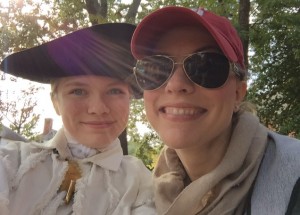 Erin’s entire family is employed at Colonial Williamsburg in some manner or other. She’s pictured here pretty much how she looks every Saturday in The Revolutionary City with her daughter Corporal Sloan, bass drummer with the Colonial Williamsburg Fifes and Drums.
Erin’s entire family is employed at Colonial Williamsburg in some manner or other. She’s pictured here pretty much how she looks every Saturday in The Revolutionary City with her daughter Corporal Sloan, bass drummer with the Colonial Williamsburg Fifes and Drums.
She spends most days in the Bruton Heights education complex, spreading the good news that is The Idea of America™, Teacher Institute, and HERO.

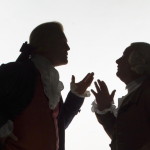


Jon says
Have a wonderful trip to New Orleans my Lady. I travel to Williamsburg a few times each year and would be very pleased to use my Jefferson Camera Obscura and a physiognotrace to do a few profiles of you. How does one find you in the city?
Gina says
She did, she was married for a couple years before she or Eliza met Hamilton! That’s one of the things he changed but had good reasons for putting the sequence of events in a satisfying narrative order. (It also gave rise to the best song in a host of spectacular songs, IMO!) But he does have Angelica say “I love my sister more than anything in this life, I would choose her happiness over mine, every time,” and then, of course, she actually does (“The Reynolds Pamphlet”). So cool that you commented here and nice to electronically meet you! I have always thought “Schuyler” is a cool name. Happy trails.
Gina says
Oops, I meant this as a reply to Jacqueline Dunn’s post, below! sorry…
Jessica says
Hi guys!
My name is Jess and I’m a journalist and podcast producer at BreakThru Radio, a multi-media platform covering independent news. One of the podcasts I host is called Biology of the Blog and revolves around interviewing one awesome blogger (such as yourself!) every week on the show. I’m wondering if you might be willing to come on air as a guest speaker in the next couple weeks and chat about Making History Now?
The interview is not done live (don’t worry), so I can edit out any verbal pauses. I’ve found the best medium is Skype (mine) to phone (yours), and can give you a call from our studio.
If this sounds like something you’d be interested in, please send me a reply along with some idea of availability over the next week or so and we can figure out more details.
Thanks so much for your time and consideration!
Warmly,
Jess Goulart
Annie says
In England, we have never had a Diana as Duchess of Devonshire. The Duchess at the time of the painting was Georgiana, first wife of the 5th Duke. She was an ancestress of Lady Diana Spencer, who married the Prince of Wales, so perhaps that’s where you’ve got confused.
Erin says
Thanks for your eagle eye Annie! Quick note on this portrait, critics were quick to praise it noting that Maria was “the first of female painters and among the male sex only inferior to her husband and Reynolds.” High praise indeed.
Jacqueline Dunn says
Erin
Read with enjoyment your blog about presenting as Maria Cosway. It may amuse you to learn that I am a great granddaughter of Angelica Schuyler Church…I grew up knowing it was Angelica’s friendship with Maria that led to the introduction to Jefferson. Best of luck with your presentation and know that you have connected with “your” BBF family…7 generations down..history is amazing..it lives and breathes..Jefferson gave his miniature to both Maria & Angelica..
Gina says
that’s awesome! How fascinating that you were raised with the story of Maria Cosway. Like many, I had never heard of her (just as Ms. Sloan suspected of her reading audience).
I would love to know if you are familiar with “Hamilton: An American Musical” and what you think of her (Angelica’s) portrayal.
Jacqueline Dunn says
Lov Hamilton the musical..?.great musical theatre.brings history to life..however bothers me a bit that she eloped in 1777.. And I believe that she loved her sister even more than Alexander..lol..but as I said great show..named my youngest son Schuyler..